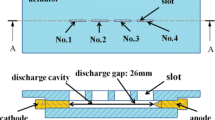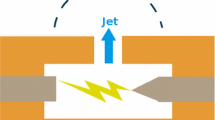Abstract
Localized arc filament plasma actuators (LAFPAs) have been developed and used at The Gas Dynamics and Turbulence Laboratory for the purpose of controlling high-speed and high Reynolds number jets. The ability of LAFPAs for use in both subsonic and supersonic jets has been explored, and experiments to date have shown that these actuators have significant potential for mixing enhancement and noise control applications. While it has been established that the actuators manipulate instabilities of the jet, the exact nature of how the actuation couples to the flow is still unclear. All of the results previously reported have been based on a nozzle extension that has an azimuthal groove of 1 mm width and 0.5 mm depth along the inner surface approximately 1 mm upstream of nozzle extension exit. The ring groove was initially added to shield the plasma arcs from the high-momentum flow. However, the effect of the ring groove on the actuation mechanism is not known. To explore this effect, a new nozzle extension is designed, which relocates the actuators to the nozzle extension face and eliminates the ring groove. Schlieren images, particle image velocimetry and acoustic results of a Mach 0.9 jet of Reynolds number ~6.1 × 105 show similar trends and magnitudes with and without a ring groove. Thus, it is concluded that the ring groove does not play a primary role in the LAFPAs’ control mechanism. Furthermore, the effect of the duty cycle of the actuator input pulse on the LAFPAs’ control authority is investigated. The results show that the minimum duty cycle that provides complete plasma formation has the largest control over the jet.













Similar content being viewed by others
References
Ahuja KK, Blakney DF (1985) Tone excited jets, part IV: acoustic measurements. J Sound & Vib 102(1):93–117
Ahuja KK, Whipkey RR, Jones GS (1983) Control of turbulent boundary layer flows by sound. AIAA Paper 1983–0726
Arakeri VH, Krothapalli A, Siddavaram V, Alkislar MB, Lourenco LM (2003) On the use of microjets to suppress turbulence in a Mach 0.9 axisymmetric jet. J Fluid Mech 490:75–98
Brown GL, Roshko A (1974) On density effects and large structure in turbulent mixing layers. J Fluid Mech 64(4):775–816
Callender B, Gutmark E, Martens S (2005) Far-field acoustic investigation into Chevron nozzle mechanisms and trends. AIAA J 43(1):87–95
Cohen J, Wygnanski I (1987) The evolution of instabilities in the axisymmetric jet. Part 1. The linear growth of disturbances near the nozzle. J Fluid Mech 176:191–219
Corke TC, Shakib F, Nagib HM (1991) Mode selection and resonant phase locking in unstable axisymmetric jets. J Fluid Mech 223:253–311
Gaitonde DV (2009) Simulation of supersonic nozzle flows with plasma-based control. AIAA Paper 2009–4187
Gaitonde DV, Samimy M (2010) Effect of plasma-based azimuthal mode excitation on supersonic jet flow. AIAA Paper 2010–4416
Grosch CE, Seiner JM, Hussaini MY, Jackson TL (1997) Numerical simulation of mixing enhancement in a hot supersonic jet. Phys Fluids 9(4):1125–1143
Heeb N, Munday D, Gutmark E, Liu J, Kailasanath K (2010) Supersonic jet noise reduction by Chevrons enhanced with fluidic injection. AIAA Paper 2010–4847
Ho C-M, Huerre P (1984) Perturbed free shear layers. Ann Rev Fluid Mech 16:365–424
Jubelin B (1980) New Experimental studies on jet Noise amplification. AIAA Paper 1980–0961
Kearney-Fischer M, Samimy M (2010) Noise control of a high Reynolds number mach 1.3 heated jet using plasma actuators. AIAA Paper 2010–13
Kearney-Fischer M, Kim J-H, Samimy M (2009a) Control of a high Reynolds number Mach 0.9 heated jet using plasma actuators. Phys Fluids 21:095101
Kearney-Fischer M, Kim J-H, Samimy M (2009b) Noise control of a high Reynolds number mach 0.9 heated jet using plasma actuators. AIAA Paper 2009–3188
Kearney-Fischer M, Kim J-H, Samimy M (2010) Flow control of a high Reynolds number mach 1.3 heated jet using plasma actuators. AIAA Paper 2010–4418
Kim J-H, Samimy M (1999) Mixing enhancement via nozzle trailing edge modifications in a high speed rectangular jet. Phys Fluids 11(9):2731–2742
Kim J-H, Kastner J, Samimy M (2009a) Active control of a high Reynolds number mach 0.9 axisymmetric jet. AIAA J 47(1):116–128
Kim J-H, Kearney-Fischer M, Samimy M, Gogineni S (2009b) Active noise control in jets from conical and contoured supersonic nozzles with plasma actuators. AIAA Paper 2009–3187
Kim J-H, Nishihara M, Adamovich I, Samimy M, Gorbatov S, Pliavaka F (2010) Development of localized arc filament plasma actuators for high-speed and high Reynolds number flow control. Exp Fluids 49:497–511
Laurendeau E, Jordan P, Bonnet JP, Delville J, Parnaudeau P, Lamballais E (2008) Subsonic jet noise reduction by fluidic control: The interaction region and the global effect. Phys Fluids 20:101519-1–101519-10
Lighthill MJ (1952) On sound generated aerodynamically. I. General theory. Proc Roy Soc London Ser A 211(1107):564–587
Lu HY (1983) Effect of excitation on coaxial jet noise. AIAA J 21(2):214–220
Michalke A (1965) On spatially growing disturbances in an inviscid shear layer. J Fluid Mech 23(3):521–544
Moore CJ (1977) The role of shear-layer instability waves in jet exhaust noise. J Fluid Mech 80(2):321–367
Plaschko P (1979) Helical instabilities of slowly divergent jets. J Fluid Mech 92(2):209–215
Saiyed NH, Mikkelsen KL, Bridges JE (2003) Acoustics and thrust of quiet separate-flow high-bypass-ratio nozzles. AIAA J 41(3):372–378
Samimy M, Zaman KBMQ, Reeder MF (1993) Effect of tabs on the flow and noise field of an axisymmetric jet. AIAA J 31(4):609–619
Samimy M, Adamovich I, Webb B, Kastner J, Hileman J, Keshav S, Palm P (2004) Development and characterization of plasma actuators for high-speed jet control. Exp Fluids 37(4):577–588
Samimy M, Kastner J, Kim J-H, Utkin Y, Adamovich I, Brown C (2006) Flow and noise control in high speed and high Reynolds number jets using plasma actuators. AIAA Paper 2006–2846
Samimy M, Kim J-H, Kastner J, Adamovich I (2007a) Noise mitigation in high speed and high Reynolds number jets using plasma actuators. AIAA Paper 2007–3622
Samimy M, Kim J-H, Kastner J, Adamovich I, Utkin Y (2007b) Active control of high-speed and high-Reynolds-number jets using plasma actuators. J Fluid Mech 578:305–330
Samimy M, Kim J-H, Kastner J, Adamovich I, Utkin Y (2007c) Active control of a mach 0.9 jet for noise mitigation using plasma actuators. AIAA J 45(4):890–901
Samimy M, Kim J-H, Kearney-Fischer M, Sinha A (2010) Acoustic and flow fields of an excited high Reynolds number axisymmetric supersonic jet. J Fluid Mech 656:507–529
Tam CKW (1998) Jet noise: since 1952. Theor Comput Fluid Dyn 10:393–405
Utkin YG, Keshav S, Kim J-H, Kastner J, Adamovich IV, Samimy M (2007) Development and use of localized arc filament plasma actuators for high-speed flow control. J Phys D Appl Phys 40(3):685–694
Viswanathan K (2002) Analysis of the two similarity components of turbulent mixing noise. AIAA Journal 40(9):1735–1744
Viswanathan K (2005) Nozzle shaping for reduction of jet noise from single jets. AIAA J 43(5):1008–1022
Winant CD, Browand FK (1974) Vortex pairing: the mechanism of turbulent mixing-layer growth at moderate Reynolds number. J Fluid Mech 63(2):237–255
Zaman KBMQ (2009) Jet noise reduction by microjets—a parametric study. AIAA Paper 2009–3129
Zaman KBMQ, Reeder MF, Samimy M (1994) Control of an axisymmetric jet using vortex generators. Phys Fluids 6(2):778–793
Acknowledgments
The support of this research by NASA Glenn Research Center with James Bridges and Cliff Brown is greatly appreciated. The authors thank Jin-Hwa Kim for his support.
Author information
Authors and Affiliations
Corresponding author
Rights and permissions
About this article
Cite this article
Hahn, C., Kearney-Fischer, M. & Samimy, M. On factors influencing arc filament plasma actuator performance in control of high speed jets. Exp Fluids 51, 1591–1603 (2011). https://doi.org/10.1007/s00348-011-1172-5
Received:
Revised:
Accepted:
Published:
Issue Date:
DOI: https://doi.org/10.1007/s00348-011-1172-5




